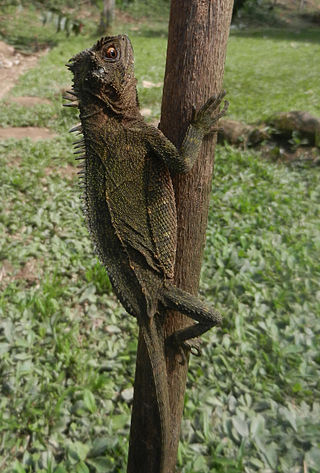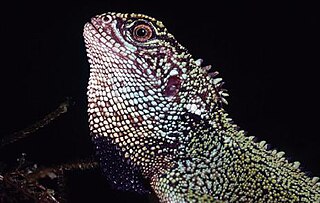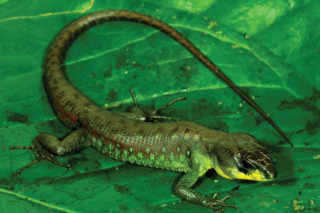
Hoplocercidae are a family of lizards native to the tropical forests, woodlands and savanna-like habitats of Central and South America. Alternatively they are recognized as a subfamily, Hoplocercinae. 20 species in three genera are described.

Enyalioides is a genus of lizards in the family Hoplocercidae. The genus is native to the northern part of South America and Panama.
The Key tegu is a species of lizard in the family Gymnophthalmidae. The species is endemic to Ecuador.

Pristimantis katoptroides is a species of frog in the family Strabomantidae. It is found in the eastern slopes of the Andes of Ecuador and Cordillera Central and eastern Andean foothills in northwestern Peru. The specific name katoptroides is Greek for "mirror-like" and refers to the similarity of this species to Pristimantis crucifer, but being found on the other side of the Andes. Common name Puyo robber frog has been proposed for it.
Pristimantis luscombei is a species of frog in the family Strabomantidae. It is known from north-eastern Peru, adjacent Amazonian Ecuador, and from Acre state, Brazil. Some of the paratypes were later identified as belonging to another species, described in 2014 as Pristimantis miktos. At the same time, Pristimantis achuar was identified as synonym of Pristimantis luscombei.

The horned woodlizard or Boulenger's dwarf iguana is a species of reptile in the genus Enyalioides, native to northern Bolivia, western Brazil and eastern Peru.

The blue-spotted woodlizard is a species of reptile in the genus Enyalioides, native to Colombia, Ecuador, and Peru.

Enyalioides laticeps, the Amazon broad-headed wood lizard, is a dwarf iguanian lizard abundantly found in Amazonian rainforests. They are semi-arboreal and mostly live in forests. Other names for it include broad-headed wood lizards, Big-headed stick lizards, Guichenot's Dwarf Iguana, Amazon Forest Dragon, or Amazon Dwarf-Iguana. It is a small, ornamented lizard that grows up to 157 mm (0.5 ft) long and have very high vertebral crests along their backs. They change colors based on environmental factors. Amazon broad-headed wood lizards rely on rapid running to move around; however, they spend the vast majority of their time motionless, blending into the rainforest background, and ambushing prey. When attacked by predators, E. laticeps may stay motionless like a wood stick to avoid predation. When found by predators, it may suddenly spring into motion, quickly reatreting to burrows in the ground.

Microlophus peruvianus, the Peru Pacific iguana, is a species of lava lizard endemic to the Ecuador, Peru, and Chile. The species is commonly attributed to the genus Microlophus but has been attributed to the genus Tropidurus.

Enyalioides azulae is a species of lizards in the family Hoplocercidae. It is known from only its type locality in the Cordillera Azul National Park in Peru.

Enyalioides sophiarothschildae, or the Rothschild's woodlizard, is a species of lizards in the family Hoplocercidae. It is endemic to the Amazonian slopes of the Cordillera Central in northeastern Peru. It differs from its congeneric species by possessing homogeneous (size) caudal scales on each caudal segment, a white gular region that has a black patch as well as turquoise scales in males, and immaculate white labials and chin.

Enyalioides anisolepis the rough-scaled woodlizard, is a species of lizards in the family Hoplocercidae. It is known from the Amazonian slopes of the Andes in southern Ecuador and northern Peru. It differs from its congeneric species by possessing scattered, projecting large scales on its dorsum, flanks, and hind limbs; a well-developed vertebral crest, with vertebrals on its neck being about three times in size compared to those between the animal's hind limbs.
Gelanesaurus flavogularis is a species of lizard in the family Gymnophthalmidae. The species is endemic to Ecuador.

Dicrodon guttulatum, the Peru desert tegu , is a species of teiid lizard found in Ecuador and Peru. It is herbivorous, with Prosopis pallida making up the majority of its diet.
Cercosaura manicata, the slender prionodactylus, is a species of lizard in the family Gymnophthalmidae. It is found in Ecuador, Peru, Bolivia, and Colombia.

Potamites strangulatus, the big-scaled neusticurus, is a species of lizard in the family Gymnophthalmidae. It is found in Ecuador and Peru.
Proctoporus bolivianus, the Bolivian lightbulb lizard , is a species of lizard in the family Gymnophthalmidae. It is found in Bolivia and Peru.
Anolis soinii is a species of lizard in the family Dactyloidae. The species is found in Peru and Ecuador.
Stenocercus humeralis, the patterned whorltail iguana, is a species of lizard of the Tropiduridae family. It is found in Peru and Ecuador.
Stenocercus puyango is a species of lizard of the Tropiduridae family. It is found in Ecuador and Peru.












